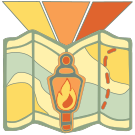Witnessing
The Concept
While doing common tasks, practice relaxing your hold on the concept that you have some sort of consciousness that directs your actions. Try to be the most mindful you can, and simply let your hold on The Self go, riding the stream of events that takes you through the task. You can do these exercises while doing any task at all, not just chores, but it may be easier to start with simple household tasks that you do every day.
Progression
As you unlearn The Self, you should be able to progress something like this.
- Small, rote tasks - combing your hair
- More complex tasks - emptying the dishwasher
- Medium complex tasks - writing an email
- Very complex tasks - writing a creative paragraph
- Long Durations - shopping
- Everyday Enlightenment
The Pattern
Each exercise will feel a little different, and there are some ideas below, but the general pattern is
- Start your task
- Become as mindful as you know how, let all thoughts evaporate, let go of any need to understand or control the moment
- Appreciate the task as a whole, sensing that it will get accomplished without you having to push it
- Begin to slowly appreciate the major steps or movements necessary to get the task done
- Once you have learned what you need from this "top down" approach, reverse the flow of observation...
- Note that the tiniest muscle movements you need for anything will never be under your conscious control - there are thousands of micromovements taking place each second
- Move up from that into an awareness of small movements that happen without any conscious thought
- Continue to move further up into the larger motions and how they also are simply taking place
- Finally note how decision making (such as when to change the comb to another hand) also do not require conscious thought
How to Approach These Exercises
The exercises below may seem very prescriptive, describing exactly what to do at each step but do not approach them that way. These are just examples showing what someone might experience, and your experience will not follow the steps given. Instead, you will have to observe your own experience and then go back and reread the exercises to understand the objective. And then try again.
Brushing Your Teeth - Beginner
This is just one example; it can be applied to any trivial activity. Note that you may not be able to do all of these steps at first - don't worry about that at all. Just try to understand the general flow and see which parts start falling into place for you. Also note that this exercise uses a mirror but that isn't a requirement at all - see for example "Emptying the Dishwasher" below.
- Stand in front of the mirror with your hands at your sides
- Become as mindful as you know how
- Look at yourself in the mirror and allow your attention to The Self evaporate and sense that the Mirror Self is going to do something
- Notice that the Mirror Self picks up the toothpaste
- Notice that the micromovements and larger movements for this simple task didn't need any conscious direction at all, it just happened
- The Mirror Self now lifts its other arm and unscrews the cap, placing it on the sink, and then picking up the toothbrush.
- Appreciate that three steps in one larger task all took place as if they were puzzle pieces fitting together seemlessly
- Continue on in this fashion as your teeth are being brushed
- Do not try and tell your Mirror Self which tooth to brush next or how long to linger on each tooth, just allow that to happen
- Do not try and tell your Mirror Self when the task is done, just let it end naturally
- Once you are done, and the toothbrush and toothpaste are back in their places, mentally review the steps listed in The Pattern above and appreciate what just happened
Emptying the Dishwasher - Intermediate
This is an example of a fairly complex task, but it involves repeating certain steps over and over, which is a chance to practice without judgement. If you find that you weren't able to stay mindful while taking one plate out, maybe you can for the next plate! Also, be sure to adapt these steps to how you personally like to empty the dishwasher, this might not be the way you do it.
- Open the dishwasher and look at the dishes
- Become as mindful as you know how
- Without trying to choose, allow yourself to pick up one dish
- Appreciate that you had no judgement or decision in which dish was picked up
- Appreciate the number of complicated micromovements necessary to pick up a dish
- Again, without any decision making, notice yourself walking to the cupboard
- Appreciate that walking also takes no conscious decisions, even though there are many parts that come together to make walking possible
- Continue on in this fashion until you find yourself back at the dishwasher, and appreciate the mindful nature of what you're doing
- Keep practicing being more and more mindful each time you put away a dish, you shouldn't need any thoughts or impulses whatsoever
- Once you are done take a moment to review the steps listed in The Pattern above and appreciate what just happened
